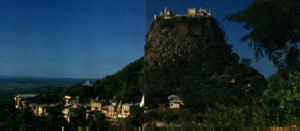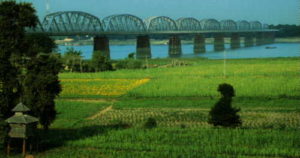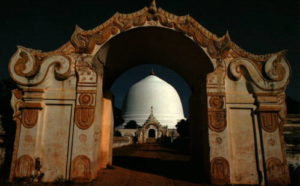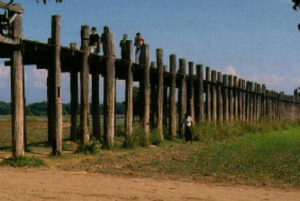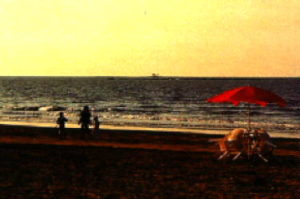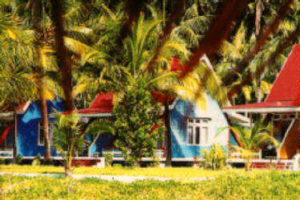Taunggyi is the capital of Shan State and it is the land of the Shans and other national races, namely, Pa-O, Kachin, Padaung, Danu, Wa, Lahu, Kaw, Maingtha, Padaung, Taungyo, Yin, Gon, Kayah, Lishau and Inntha with their unique cultures. The Shan plateau is about 3,000 to 4,000 feet above sea level. Some ranges are 5,000 to 7,500 feet high, with even higher peaks. A cool climate makes it a highly popular summer resort. Its temperatures range from around 60 degrees Fahrenheit in the cool months of December and January, to 70 or 80 even in the warmest months of April, May, June and July.
Inle Lake is the most famous scenic spot in the Shan State. It is about 30 km south of Taunggyi, capital of the Shan State. The Lake is 22.4 km long and 10.2 km wide, shallow and extremely picturesque. It is studded with floating islands formed by the growth and decay of vegetation.
Sheltered among the hazy blue mountains, the Lake is about 900 metres above sealevel. The lake is very popular with foreign tourists. It is famous for its unique leg-rowers, floating villages and colourful markets and festivals. Even when it is not festival time, it is very interesting to observe the Innthas live on the lake with their houses on stills, floating farms and the floating markets.
The Innthas have become so adapted to the lake environment that they build their homes over the water on stills, they build floating farms on the lake and villagers row their long, narrow boats with unique way of leg-rowing that has made them famous.
MOUNT POPA
In 442 B.C., a great earthquake roared through central Myanmar – and from out of the barren Myingyan plains rose Mount Popa. Volcanic ash on the mountain slope gradually became fertile soil, and the peak blossomed with flowers of many colors. (Popa is the Sanskrit word for “flower.”) For the inhabitants of the surrounding regions, the “sugar-loaf’ peak becaml regarded as the home of the gods, the Mount Olympus of Myanmar. Alchemist and occultists made their home on the mountain slopes, and others were con vinced mythical beings lived in the woods and among the flowers. So it was a matter of course when Mount Popa became the focus of national nat worship and the of ficial home of the Mahagiri Nats during the reign in Bagan of King Thinlikyaung.
Mount Popa, 1,518 meters (4,981 feet high, is located about 50 km (31 miles southeast of Bagan. It’s a 200-kyat Jeep trip from Bagan village, or a fatiguing bus trip requiring transfers in Nyaung U and Kyaukpadaung. Overnight visitors can stay at the ancient Popa monastery at the foot of the peak, however. During the month of Nayon (May/June) the annual Festival of the Spirits is held here, and it is said that at that time the abbot of the Popa monastery runs the largest hotel in the whole of Myanmar.
While the volcanic cone can be climbed by means of a path beginning at the monastery, it should be attempted only by the physically fit. The mountain rises about 1,000 meters (3,280 feet) above the surrounding plain, and given the hot, dry climatic conditions that prevail in central Myanmar, the ascent can be arduous. On clear days, however, the view from the top across the vast dry plain is the most beautiful panorama that can be seen in central Myanmar.
The goal of a trip to Mount Popa should be to see the shrine of the Mahagiri Nats, situated about halfway up the mountain. For seven centuries preceding the reign of Anawrahta, all kings of central Myanmar were required to make a pilgrimage here to consult with the two nats regarding their reign .
SAGAING
Sagaing lies 21 km south-west of Mandalay on the west bank of the Ayeyarwady River. Sagaing became a capital of an independent Shan kingdom around 1315 after the fall of Bagan had thrown central Myanmar into chaos. Its period of importance was short for in 1364 the founder’s grandson, Thado Minbya, moved his capital across the river to Inwa. For four brief years from 1760 to 1764 Sagaing was once again the capital. Today, Sagaing is known as a meditation centre. Myanmars, ail over the country would visit Sagaing for the purpose of religious retreat.
Sagaing Hill
It is known as a religious retreat where over 600 monasteries for monks and nuns are located for Buddhistic studies and meditation. The Padamyazedi dates from 1300 while the Onhmin Thonze or thirty caves pagoda has many Buddha images in a crescent shaped colonnade. Mural paintings ean be seen in the Tilawkaguru cave temple which was built around 1672. The Pa Ba Gyaung is typical of the many monasteries on the hillside. And at the nearby village of Ywahtaung you can see silver workers producing bowls and other silver items by traditional methods.
Inwa Bridge
The road to Sagaing crosses the river on tht sixteen span Inwa Bridge which is well over a km long. Opened in 1934 the bridge was put out of action by the British in 1942 when they demolished two spans in order to deny the bridge to the advancing Japanese. Not until 1954 was the bridge repaired and put back into operation. There’s a toll to take cars across the bridge which also carries the rail line. Inwa Bridge used to be the longest-bridge in Myanmar until the emergence of Thanlyin Bridge in 1993.
Thabyedan Fort
Just to the left of the bridge, on the Mandalay and Inwa side, is the fort of Thabyedan which was built as a last ditch defence by the Myanmar before the third Anglo-Myanmar war.
Kaunghmudaw Pagoda
This huge pagoda is 10 km beyond the town of Sagaing. The enormous dome rises 46 metres (151 feet) in the shape of a perfect hemisphere and was modelled after the Mahaceti Pagoda in Ceylon. Also known as Rajamanisula, the pagoda was built in 1636 to commemorate Inwa’s establishment as the royal capital of Myanmar. Around the base of the pagoda are 812 one and a half metre high stone pillars. The 86 lines of Myanmar inscriptions on the slab record details of the pagoda’s construction.
Tupayon Pagoda
Constructed by King Narapati of Inwa in 1444, the Tupayon is of an unusual style for Myanmar consisting of three circular storeys each encircled with arched niches.
Aungmyelawka Pagoda
Situated on the riverfront, near Tupayon, this pagoda was built in 1783 by Bodawpaya on the site of his residence before he became king. It is built entirely of sandstone in imitation of the Shwezigon Pagoda at Nyaung-Oo in Bagan. It is also knows as the Eindawya Pagoda.
Datpaungzu Pagoda
It is comparatively recent but houses many relics from other, older pagodas which were demolished when the railway was built through Sagaing.
Ngadatkyee Pagoda
This was built in 1657 and houses a fine and very large seated Buddha image.
Hsinmyashin Pagoda
It is known as the Pagoda of Many Elephants. It Is built in 1429 . Badly damaged in an earthquake in 1485, It was subsequently repaired but suffered even worse damage in a quake in 1955.
AMARAPURA
Situated about 11 km south of Mandalay, Amarapura is an ancient capital of the Konbaung Dynasty. The modern town of Amarapura is often referred to as Taungmyo “the southern city” to distinguish It from Mandalay, the northern city. The old name means “city of immortality” but Amarapura’s period as capital was brief. Amarapura was founded as his new capital by Bodawpaya in 1783, soon after he ascended to the throne. In 1823 Bagyidaw moved back to Inwa. In 1841 Amarapura again became the capital but in 1857 Mindon decided to make Mandalay the capital and the changeover was completed in 1860. There are several interesting sltes to be seen. Amarapura was also the slte for the first British embassy in Myanmar in 1795. Amarapura is noted for silk and cotton weaving and bronze easting.
Patodawgyi Pagoda
Built by Bagyidaw in 1820 this well preserved pagoda stood outside the old city walls. The lower terraces have marble slabs illustrating scenes from the Jataka. You’ll have a fine view over the surrounding countryside from the upper terrace. An inscription stone, within the temple precincts, details the history of the pagoda’s construction.
Palace Ruins
Little remains of the old Amarapura palace but you can still find two masonry buildings — the treasury building and the old watchtower. King Bagyidaw and King Bodawpaya were both buried here and their tombs also remain. The corner pagodas still stand at the four corners of the once square city.
U Bein’s Bridge
South of the Patodawgyi Pagoda the shallow Taungthaman Lake is crossed by a huge teak bridge. During the dry season the bridge crosses dry land. U Bein was the “mayor” at the time of the shift from Inwa and he wisely salvaged material from the deserted Inwa Palace to build this km long footbridge. It has stood the test of time for two centuries.
Kyauitawgyi Pagoda
This was constructed in 1847 by King Bagan it was modelled on the larger Ananda Temple at Bagan.
INWA
A few km south of Amarapura the Inwa Bridge spans the Ayeyarwaddy to Sagaing. It’ at present the only bridge across the Ayeyarwaddy though another bridge crossing the river is now under construction near the city of Pyay (Prome). Just south of the bridge, the Myitnge River flows into the Ayeyarwaddy and south of this river stands the ancient city of Inwa. A channel, known as the Myittha Chaung, was cut across from the Myitnge to the Ayeyarwaddy to make Inwa into an island. From 1364, Inwa was the capital of a Myanmar kingdom for nearly 400 years until the shift was made to Amarapura in 1841.
Watch Tower
The 27 metre (90 feet) high masoruy watch tower, the Nanmyint is remains of the palace built by Bagyidaw – it’s the “leaning tower of In-wa”.
Naha Aunlpnye Bonzan
Also known as the Ok Kyaung this is a masonry monastery built by the chief queen of Bagyidaw for her royal abbot Nyaunggan Sayadaw in 1818. Monasteries were normally built of wood. Although this monastery was built in imitation of the traditional wooden style, its masonry construction has ensured its survival. The 1838 earthquake badly damaged it but in 1837 it was restored.
What else to see
Farms, villages, monasteries and ruined pagodas are scattered around the area within the old city walls, the walls are in particularly good condition near the northern gate, facing the Ayeyarwaddy. This was known as the Gaung Say Daga or “hair-washing”gate since kings had their hair ceremonially washed at this gate.
The Htilamgshin Pagoda dates back to the Bagan period and in a shed near the pagoda stands an inscription recording the consruction of the wooden palace during the first Inwa dynasty. The Bagaya Kyaung is a wooden monastery of a later period than the masonary Maha Aungmye Bonzan. To the south side of the clty stand the remains of the huge four-storey Layhtatgyi Pagoda. There is also the Lawkatharaphu Pagoda whtie to the south of the city stands the Inwa fort.
MINGUN
It is about 11 km upriver from Mandalay on the opposite bank of the Ayeyarwaddy and accessible only by river. A 45-minute boat trip to Mingun is very pleasant with plenty of life on the river to see.
Mingun Pagoda
If King Bodawpaya had succeeded in his grandiose scheme Mingun might now have the world’s largest pagoda. When Bodawpaya died in 1819 construction was abandoned. Each side of the enormous base measures 72 metres (235 feet) and the lowest terrace measures 140 metres (450 feet). There are projecting arches on each of the four sides.
Pondawpaya
Closer to the riverbank a littie downstream from the Mingun Pagoda is this five metre (15 feet) high working model for the gigantic structure. It gives a clear picture of just what Bodawpaya intended to achieve.
Hsinbyume or Myatheindan Pagoda
Built by King Bagyidaw in 1816, three years before he succeeded Bodawpaya as king, the pagoda was constructed in memory of his senior wife the Hsinbyume princess. It is built as a representation of the Sulamani Pagoda which, according, to the Buddhist plan of the cosmos, stands atop Mount Meru. The seven wavy terraces around the pagoda represent the seven mountain ranges around Mount Meru. This pagoda was badly damaged in 1838 by a quake but King Mindon restored it in 1874.
Settamra Pagoda
Close to the riverbank downstream from the Pondawpaya model, the hollow, vaulted shrine has a footprint of the Buddha which was brought to Mingun by King Bodawpaya when the relic chamber in the base of his huge pagoda was sealed up. The temple was built in 1811.
Mingun Bell
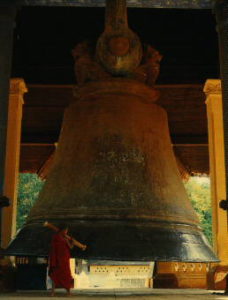 In 1790 Bodawpaya had a gigantic bell cast to go with his gigantic pagoda. Weighing 90 tons it is claimed to be the largest hung, uncracked bell in the world. The bell is about four metres high and over flve metres (15 feet) in diameter at the lip. You can scramble right inside it and some helpful bystander will give it a good thump so you can hear the ring from the interior.
In 1790 Bodawpaya had a gigantic bell cast to go with his gigantic pagoda. Weighing 90 tons it is claimed to be the largest hung, uncracked bell in the world. The bell is about four metres high and over flve metres (15 feet) in diameter at the lip. You can scramble right inside it and some helpful bystander will give it a good thump so you can hear the ring from the interior.
KYAIKHTIYO PAGODA
 The famous legendary Pagoda on the Goldern Rock about 160 Km from Yangon and 11 km of hiking from the base camp at Kyaikhto. Visitors can also go by car up to a point about a mile away from the Pagoda.
The famous legendary Pagoda on the Goldern Rock about 160 Km from Yangon and 11 km of hiking from the base camp at Kyaikhto. Visitors can also go by car up to a point about a mile away from the Pagoda.
NGAPALI BEACH

The beautiful Ngapali Beach is located in Thandwe (Sandoway) about an hour flight from Yangon. This unspoilt beach stretches over 3 Km and an ideal place for everyone who loves seasand and sun or swimming, snorkelling or carefree loitering on the beach exploring or just sitting amidst whistling wind.
KYAING TONGE
Kyaing Tonge, a capital city in Eastern Shan Stute, is known for its scenic beauty and colourful hill tribes. The 0 road from Tachilek to Kyaing Tonge inds 160 km over the mountains, forests, streams and tribal viliages. -Places of- interest in Kyaing Tonge include Maha-Myat-Muni Pagoda; Naung–Tong,Lake, Sunn-Taung Monostery, Hot spring and One Tree Pagoda. Loi-mwe, meaning misty mountsin over l600 meters-above the sea level is located 33 km away from Kyaing Tonge.
MRAUK U
The ancient city of Rakhine Kingdom (15th century is known for its old temples with wall paintings of Indian cultural influence Mrauk-U is reached by boot along the capital of Rakhine State. A boat trip takes about 5 hours.
The highlights of Mrauk-U are the massive Shitthaung-paya, a curtously, remarkable temple with countless. Buddha imeges and reliefs, the fortress-like temple Htaukkan-thein noted for the interesting stone sculptures temple And aw-thein with its unique stone carvings and floral designs; Sakya-man-aung, a tall atternuated stupa; did Archaeologicol.Museum.
Chaung Tha Beach
It is a pleasure to visit the unspoiled Chaung Tha Beach. Just half-a-day drive from Yangon via Pathein.
Sightseeing:
Po Kalar Island
The Phyu Island
Kyauk Maung Nhama
Specialities:
– a variety of seafoods
– crayfish and lobster
To double your pleasure there, you can stay in comfoft at Chaung Tha Beach Hotel(Bungalow- Type). The beach is in West Pathein Township, Ayeyarwaddy Division.
Contact:
Yangon Office Tel: 95-01-89589
(Car-Rental) Tel: 95-01-96987
Chaung Tha Hotel Tel: 95-042-22587
Kannthaya seaside resort
The news is encouraging. Myanmar will have one more new seaside resort in Rakhine State in addition to existing unspoilt, beautiful Ngapali, Chaungtha, Maungmagan and Setse beaches.
The new beach is named “Kannthaya” and goes well with its name, for “Kann” literally means “seaside” or “beach” and “thaya” implies “pleasant” or “beautiful”.
Located 17 miles north of Gwa, the largest township in the southernmost part of Rakhine coastal strip, the new resort can be reached within a few hours’ drive from Yangon. It stretches 8,000 yards with clean, clear, blue and shallow water and with glistening and dazzling sand which will be appreciated by nature-lovers and travellers at home and abroad. New bungalows, a golf course and world standard hotels are under construction now to provide all possible modern facilities creating the beach to appear as a really attractive seaside resort to be thriving in the near future.
Kyaik Kha Hmi – Set-Se Beach
Kyaik Kha Hmi is a small town situated on the Tanintharyi Coast, South-West of Thanbyuzayut. And the town is very famous for its “Ye Lei Pagoda”. There also the beautiful beach called “Set-Se” and it is very contenient for everyone to take bus drive from Mawlamyaing within a couple of hours.
Moung Magan Beach
Moung Magan Beach is in Dawei Township also on the Tanintharyi Coastal region. There ia an aerogare for domestic flights.
Ayeyarwady Princess Launched
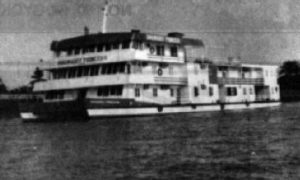 The first luxurious and comfortable cruise along the Ayeyarwaddy River from Mandalay to Bagan has been launched by Barani Hotel and Trading Group Ltd on 2nd November, ’94 at Bagayar Jetty, Yangon. The boat which is constructed by United Engineering Co., Ltd (Union of Myanmar) is named Ayeyarwady Princess and has 30 fully air-conditioned rooms, buffet dining, sun deck and cocktail on board. It is learnt that the Ayeyarwady Princess can accommodate 120 passengers. Enquiries can be made for more information at Barani Hotel & Trading Group Ltd., No. 7l, Min Ye Kyawswa Road, Ahlone Township, Yangon. Tel: 95-01-20854, 95-01-23104.
The first luxurious and comfortable cruise along the Ayeyarwaddy River from Mandalay to Bagan has been launched by Barani Hotel and Trading Group Ltd on 2nd November, ’94 at Bagayar Jetty, Yangon. The boat which is constructed by United Engineering Co., Ltd (Union of Myanmar) is named Ayeyarwady Princess and has 30 fully air-conditioned rooms, buffet dining, sun deck and cocktail on board. It is learnt that the Ayeyarwady Princess can accommodate 120 passengers. Enquiries can be made for more information at Barani Hotel & Trading Group Ltd., No. 7l, Min Ye Kyawswa Road, Ahlone Township, Yangon. Tel: 95-01-20854, 95-01-23104.
 One can also sail down the Ayeyarwady by riverboat from Mandalay to Bagan, a 165 Kilometres downstream, wondrous journey.
One can also sail down the Ayeyarwady by riverboat from Mandalay to Bagan, a 165 Kilometres downstream, wondrous journey.

